MOIRCS LightSmyth Grism Information Page
Observation under the Shared-Risk Policy
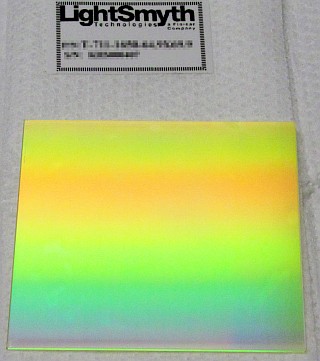
Introduction
The team of scientists in Tohoku Univ., Riken, Subaru Telescope, NAOJ, Univ. of Tokyo etc have developed the new grisms ("LightSmyth J/H"). They will have similar spectral resolution to the existing VPH grisms, but with higher and much flatter transmission curve. The dependence of the sensitivity with the slit position is minimal, which is the advantage of the LightSmyth grism over VPH. When you publish the result based on the grisms, please give acknowledgement to the PI, Prof. Kodama, as well as the citation to the SPIE paper.
The Team
- PI: Tadayuki Kodama (Tohoku Univ.)
- Development Team:
Noboru Ebizuka (Riken, Lead), Ichi Tanaka, Takashi Hattori (Subaru Telescope), Kentaro Motohara (NAOJ/Univ. Tokyo), Koji Omata (NAOJ), Hidenori Takahashi, Masahiro Konishi (Univ. Tokyo) - Science Collaborators:
Masato Onodera, Yusei Koyama (NAOJ), Masao Hayashi (NAOJ), Hidenobu Yajima (Tsukuba Univ.)
This project is supported by the JSPS KAKENHI Kiban-A Grant Number 18H3717. We also acknowledge the cordial financial support from Subaru Telescope. We would also thank significant technical support from the Advanced Technology Center (ATC), NAOJ, and the member of the Instrument division in Subaru Telescope.
Specification
The table below describes the basic specification of grisms. These values may still change occasionally as the characterization proceeds.
| LS-J | LS-H | |
|---|---|---|
| Resolution(1) | 3490 | 3390 |
| Straight-through Wavelength [um](2) | 1.242 (Channel 1) 1.242 (Channel 2) |
1.625 (Channel 1) 1.625 (Channel 2) |
| Pixel Scale [A/pix] | 0.834 (Channel 1) 0.834 (Channel 2) |
~1.122 (Channel 1) ~1.122 (Channel 2) |
| Shift of spectra in spatial direction [pix](3) | 43 (Channel 1) -5 (Channel 2) |
0 (Channel 1) +5 (Channel 2) |
| Spectral Tilt (deg: CCW=+) | ~0 (ch1) ~0 (ch2) |
0.3 (ch1) -0.2 (ch2) |
| Sensitivity(4) | 20.2 | 20.1 |
(1) Values are for 0.5"-width slit and at the straight-through wavelength. Spectral resolution is roughly proportional with the slit width till 0.3" slit width (or less). If seeing is better than slit width, spectral resolution for object is basically determined by the object size in the slit.
(2) Measured in July 2020. The value will shift slightly (30-50A level) with the slit position.
(3) In the preimage coordinate (=X_pre). In the raw image coordinate, positive shift in X_pre will be negative shift in Y (raw). See the example for definition.
(4) Note that they are NOT based on the actual measurements. Estimated sensitivities listed are for a 5 sigma detection per pixel (in 1-D spectra) in 1 hour of on-source background-limited spectroscopy (0.5" slit and the object size are assumed: in vega mag) between the night sky emission lines. The values are estimated from the VPH data but also considering slightly better throughput of ZnSe prisms than VPH.
Grism Efficiency and its Characteristics
The figure below shows the measured total efficiency of the LS_J and LS_H grisms. There should still have some position dependence of the efficiency with the slit position, especially for LS_J. We will update the figure when the measurement is done soon.
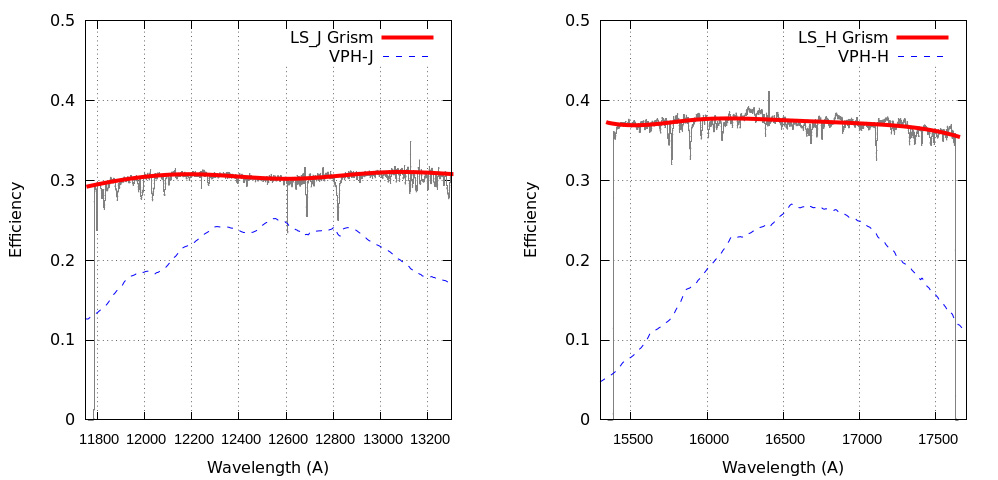
Figure 1: The measured total throughput of the LS-J and LS-H grisms. Also shown in each figure is of the VPH-J (left) and VPH-H (right) for reference. They are measured with a slit near the center of channel 1.
The figure below is the grating-only efficiency.
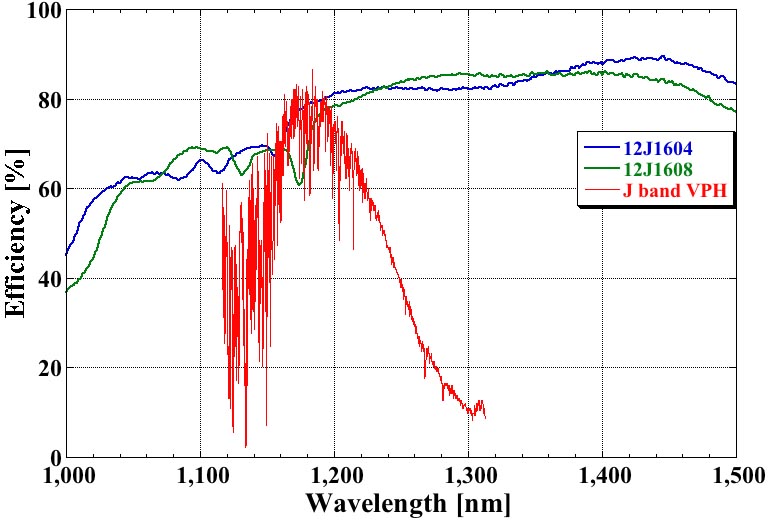
|
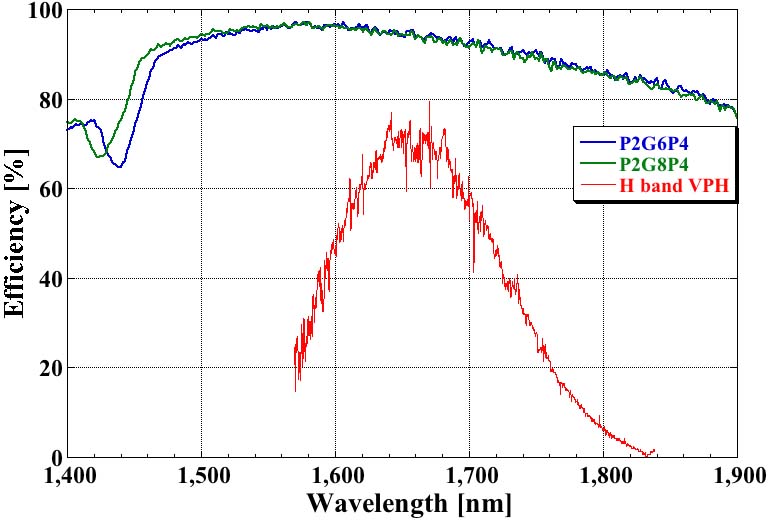
|
Figure 2: The laboratory measurement of the throughput of the LS-J and LS-H grisms (images by courtecy of Dr. Ebizuka). Also shown in each figure is of the current VPH-J (left) and VPH-H (right). Almost all the J- and H-band window can now be covered by the region of T > 60 % for J and T > 90 % for H. Though there is a small dip near 1.15 micron for J and 1.45 micron for H, respectively. They can be dismissed by dome flats.
Ghosts
The grisms show some complex ghosts of the slit pattern. They are undispersed, so likely due to internal reflection of the 0-th order light. They are fairly constant in the strength, so the regular A-B sky subtraction effectively suppress the pattern. However, it occasionally remains when the temperature change is large.
The pattern can be sampled during the calibration data acquisition. We will provide the data as a part of calibration process.
The pattern sometimes resembles emission lines. Users should be careful about these spurious signals.
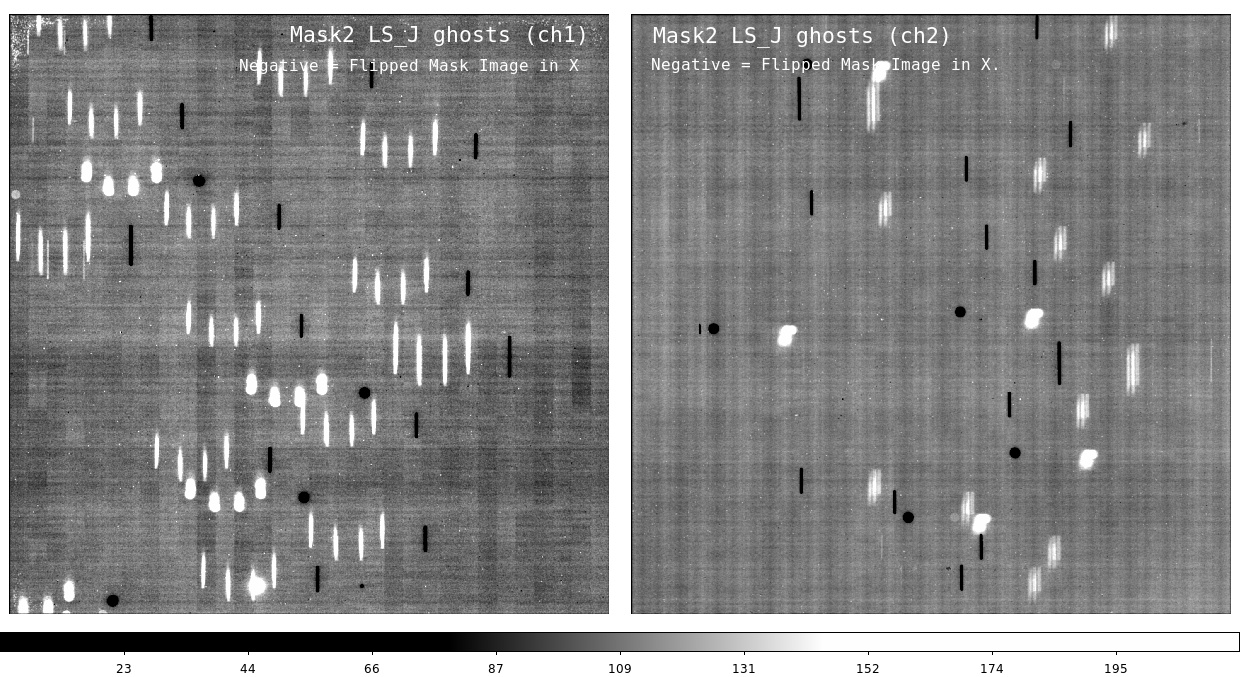
|
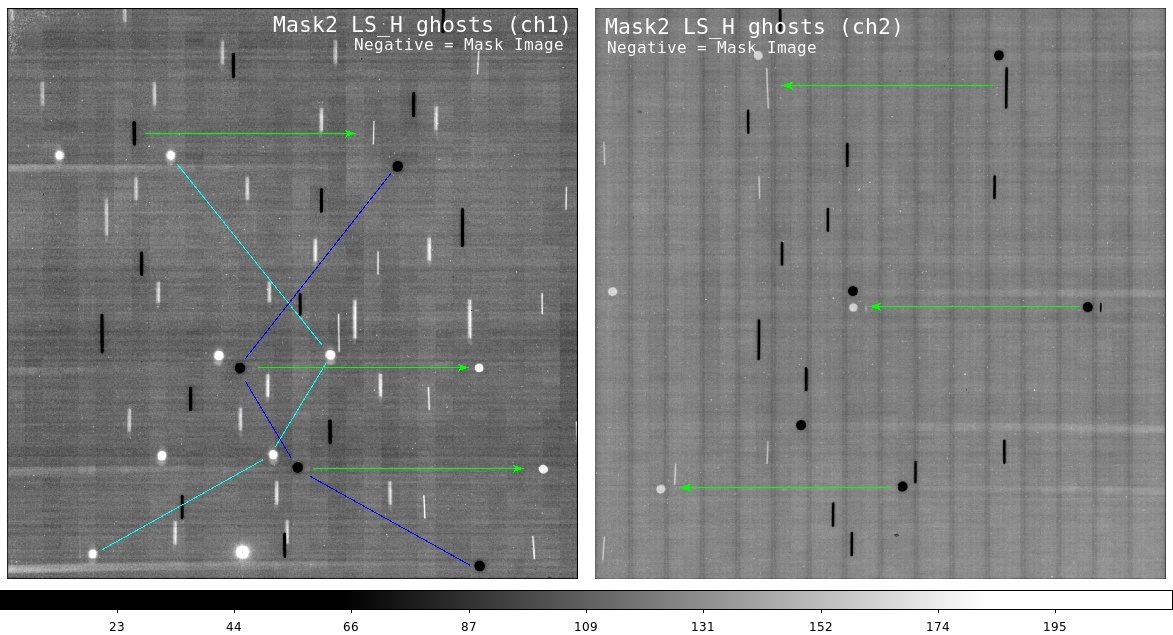
|
Figure 3: The ghost patterns observed in a MOS data for LS-J(Left) and LS-H (Right) grisms. The pattern is embedded in the spectral data. We can sample the ghost pattern only using K-band light with the grisms.
The wmdp Design
The mask design software (wmdp_moircs.sav) includes these grisms in the Grism Select menu. If not, please update your wmdp_moircs.sav software to the most recent version.
A difficulty during the mask design is that it is not straightforward to see the observable range of the spectra at a slit position. During the recent update of the wmdp_moircs software, we added dashed lines on the graphic for spectra so that you can somehow see the range of the spectra. Please check the mask design manual on how to use them.
The Observation
We can achieve the background-noise limited observation for the LightSmyth grisms for normal slit width case within a reasonable exposure times (<15min per exposure) with 16-25 times multi-sampling CDS readout. However, staying at each dither position too long will change the night emission line condition, then it might result in poor sky subtraction. As a compromise, we recommend to use 4-8 min. exposures (less than 10 min.) for each dither position. As our experience is limited, we appreciate your feedback.
A challenge during the science observation is the observation of the standard stars. As the generated spectra by the LightSmyth grisms are longer than the detector size, observing standard star data at a single slit position does not cover all the spectral range covered by a MOS observation. So, we have to take the standard star data at 2-3 different slits (to cover shortest/typical/longest wavelength range covered by a MOS). But the process (doing the standard star acquisition on these slits) will take time. We used to try the slitless spectroscopy for standard star obs. But this is also challenging for the accurate telluric correction. For now, we consider the standard star acquisition by 2-3 slits for each channel is the best way. Please keep 40-50 minutes for a standard star observation. Again, your feedback is greatly appreciated.
Any questions should be directed to the Support Astronomer (Ichi Tanaka: e-address is below).
Last update: 2024-07-25 by Ichi Tanaka (ichi$naoj.org [change $ to @])